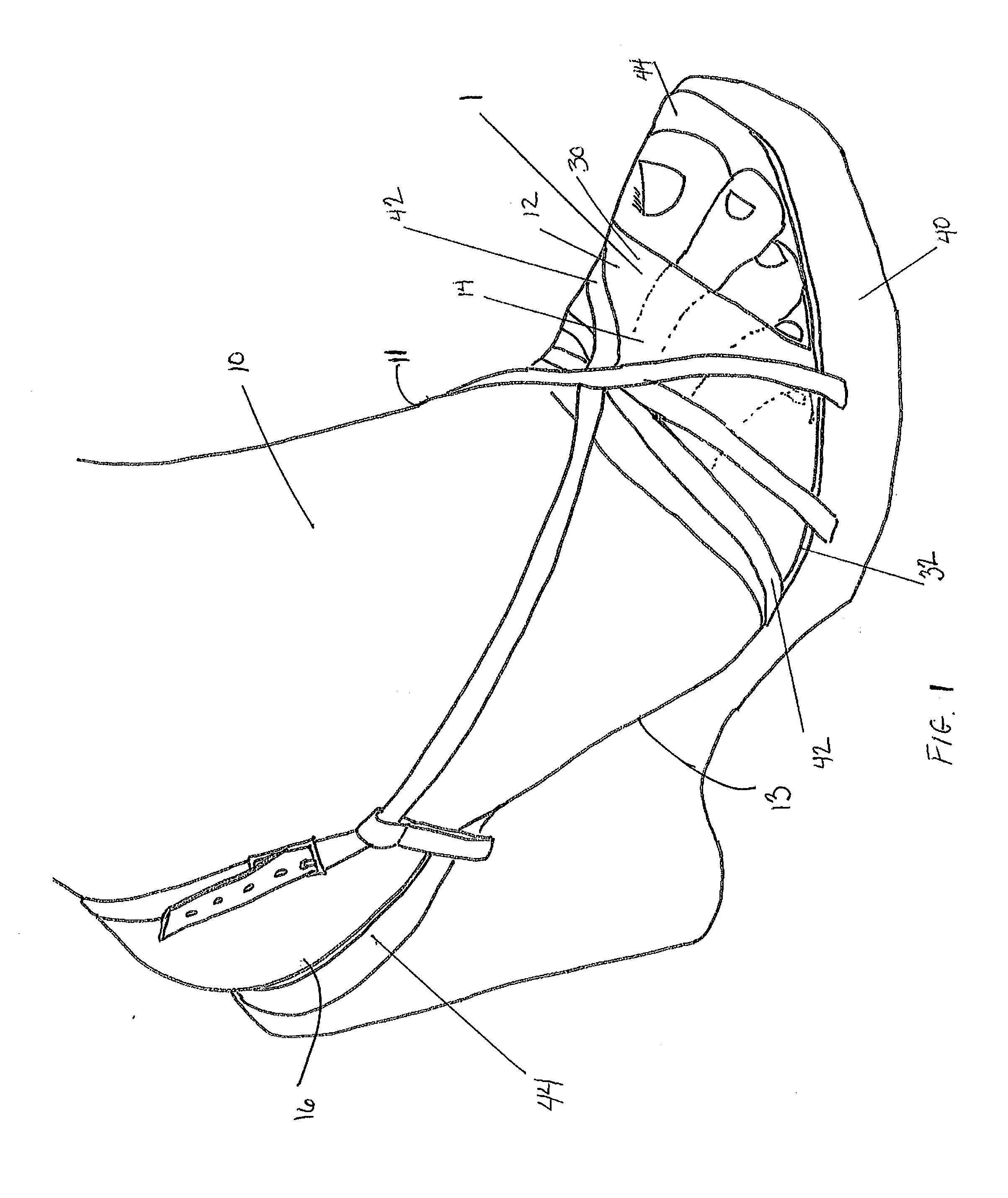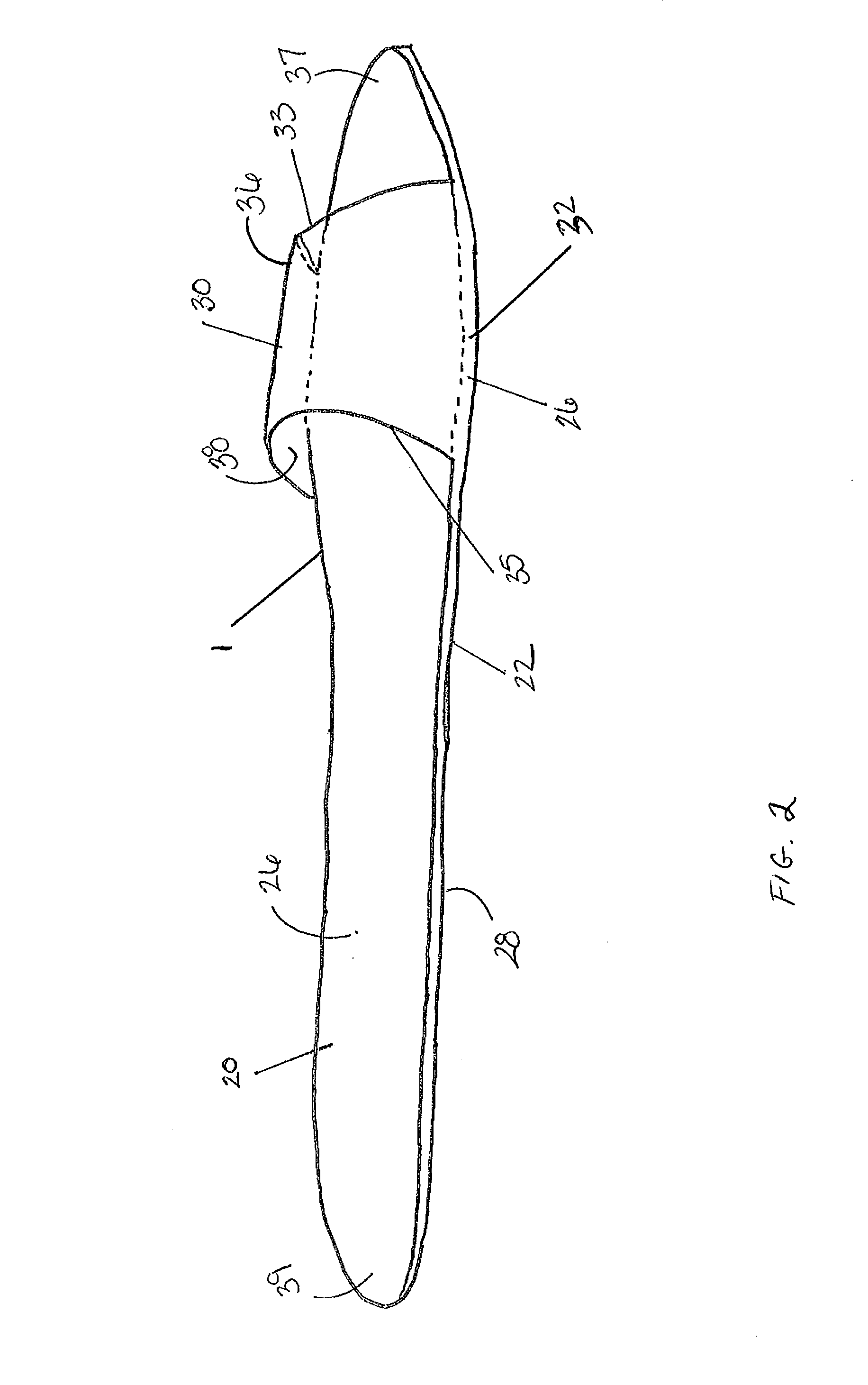Over a period of time, the shoe sections that run across the portions of the foot have the potential for applying pressure and friction to the wearer's foot and causing that person to experience excess pressure, pain, or resulting in irritations and
blisters.
This problem affects the wearer and the wearer's foot in using certain shoes daily and may even
impact the wearer's foot for days after the use depending on the duration of wear and the
exertion of force and pressure upon the foot.
Thus, the wearer is impeded from the general use of particular shoes in everyday living.
In addition, the wearer may also experience discomfort on the bottom sole of the foot.
Such insoles have proven less than ideal in aspects that address comfort to the front and top portions of the foot that may come in contact with sandal straps that cause pressure and irritations.
Most, if not all, of these relief paddings are limited to individual spot relief and do not provide relief for portions of the foot that extend beyond a limited, isolated area, nor do they provide relief for strap configurations across the top and front portions of the foot.
Conventional insoles and relief pads suffer from a number of drawbacks to address the problem of sandal straps potentially applying excessive force and causing irritations on the top and front portions of the wearer's foot.
One such drawback is that conventional insoles allow the wearer to experience comfort only on the sole of the foot.
In addition, relief pads only provide comfort to limited points of contact between the shoe and the foot and only provide a temporary solution as these pads must be applied, and removed daily, and new pads must then be reapplied for the next wear of the shoe.
This type of padding relief is temporary and only provides a single
daily wear use to be applied and removed daily.
Therefore, the use of conventional relief insoles or padding is not conducive for use in situations requiring coverage beyond limited areas like the sole of the foot or specific isolated spots.
Conventional insoles and padding do not address the problems encountered with sandals having a number of thin straps spaced and oriented such that the straps run across a front and top portion of the foot.
Thus, conventional insoles do not alleviate problems typically encountered from the excessive pressure and irritations caused by sandal straps that are in touch with the wearer's foot.
Another common drawback associated with specific, spot comfort padding is that it typically allows only a limited area of the foot to come into contact with the padding and does not fit over the entire front and top foot portion that requires relief of pressure and
irritation.
These uses, however, are not an effective or productive use for these padding products, as the shape of the padding is not suited for multiple pads to be used at once or for more than one use.
In addition, this type of padding could not accommodate thin straps and would be a visual eye sore and be too cumbersome to wear multiple pads.
Furthermore, the padding is usually too thick to accommodate the space between the wearer's foot and the sandal, thereby putting additional discomfort on the wearer by consuming space and creating tension or tightness on the foot against the padding and shoe.
Hence, the external force applied by a walking movement may quickly lead to pressure, discomfort and / or irritations on the foot.
In addition, another drawback is that the tape or spot relief padding may shift during use and leave a tacky
adhesive residue against the wearer's
skin that must be removed via a
rubbing motion or removal liquid such as
soap,
rubbing alcohol, or baby oil.
In some cases the tacky,
adhesive residue becomes a difficult task to fully remove on the inside of the shoe itself, thus imposing the wearer to continue to feel a residual substance against the foot during future use.
This type of padding is not conducive to relieving pressure from sandal straps running across the front and top portions of the foot, as the
toe pouch padding would be visually apparent underneath the straps and would appear outside of the shoe or in between the plurality of spaced apart straps, which is not the intention or purpose of that product.
A person wearing sandals having a number of spaced apart straps, where the straps are positioned across the front and top area of the foot, may end up experiencing excess forces from the straps and irritations on those portions of the wearer's foot that come into contact with those straps.
With continuous, repeated use of these types sandals, the wearer experiences unnecessary pressure and
skin irritations caused by the straps, and the wearer's use of particular sandals is uncomfortable or impeded, thus interrupting the wearer's selection of shoes, everyday living and continuous daily activities.
Despite the existence of many types of insoles and padding to facilitate comfort for one wearing shoes, the sandal wearer continues to experience pressure and irritations on the top and front portions of the foot that come into contact with troublesome straps.
 Login to View More
Login to View More  Login to View More
Login to View More 


